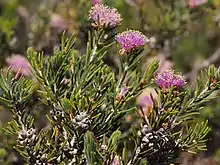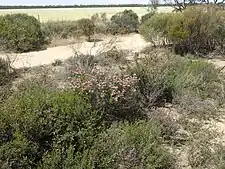| Melaleuca wonganensis | |
|---|---|
 | |
| Scientific classification | |
| Kingdom: | Plantae |
| Clade: | Tracheophytes |
| Clade: | Angiosperms |
| Clade: | Eudicots |
| Clade: | Rosids |
| Order: | Myrtales |
| Family: | Myrtaceae |
| Genus: | Melaleuca |
| Species: | M. wonganensis |
| Binomial name | |
| Melaleuca wonganensis | |
Melaleuca wonganensis is an erect shrub in the myrtle family Myrtaceae and is endemic to the south-west of Western Australia. It is a shrub with narrow leaves and purple to deep mauve flowers and is restricted in its distribution to the Wongan Hills district.

Description
Melaleuca wonganensis grows to a height of 1–1.4 m (3–5 ft). Its leaves are arranged alternately, are linear to tear-drop shaped with a very short stalk and a rounded end. The leaves are 7.5–20 mm (0.3–0.8 in) long and 0.8–1.4 mm (0.03–0.06 in) wide, often covered with fine hairs and have three longitudinal veins.
The flowers are arranged in heads about 25 mm (1 in) in diameter, near the ends of the branches, with two to five groups of flowers, each with three individual flowers. The flowers appear in September and October and are purple or deep mauve. The stamens are arranged in bundles of five around the flower, with seven to ten stamens in each bundle. The base of the flower is hairy and 2.0–2.5 mm (0.08–0.1 in) long. The fruit are woody capsules 3–4.5 mm (0.1–0.2 in) long and wide.[2][3]
Taxonomy and naming
Melaleuca wonganensis was first formally described in 1999 by Lyndley Craven in Australian Systematic Botany.[4][5] The specific epithet (wonganensis) is a reference to its distribution in the Wongan Hills district.[3]
Distribution and habitat
This melaleuca occurs only in the Wongan Hills district. It usually grows in depressions near salt lakes in calcareous soils.[6] It grows in dense scrub or heath on sand, clayey sand with lateritic pebbles and sand over granite and laterite.[3] The type specimen has the note that it was collected on "Gently undulating terrain, east of hills, orange clayey sand with numerous lateritic pebbles. Melaleuca heath-thicket by side of road. Locally common."[7]
Conservation
Melaleuca wonganensis is classified as "not threatened" by the Government of Western Australia Department of Parks and Wildlife.[6]
Uses
Essential oils
This leaf oil of this species is mostly monoterpenes yielding about 0.5% (weight/weight) from fresh leaves.[3]
References
- ↑ "Melaleuca wonganensis". Plants of the World Online. Retrieved 14 September 2021.
- ↑ Holliday, Ivan (2004). Melaleucas : a field and garden guide (2nd ed.). Frenchs Forest, N.S.W.: Reed New Holland Publishers. p. 226. ISBN 978-1876334987.
- 1 2 3 4 Brophy, Joseph J.; Craven, Lyndley A.; Doran, John C. (2013). Melaleucas : their botany, essential oils and uses. Canberra: Australian Centre for International Agricultural Research. p. 391. ISBN 9781922137517.
- ↑ "Melaleuca wonganensis". APNI. Retrieved 12 March 2015.
- ↑ Craven, L. A.; Lepschi, B. J. (1999). "Enumeration of the species and infraspecific taxa of Melaleuca (Myrtaceae) occurring in Australia and Tasmania". Australian Systematic Botany. 12 (6): 915. doi:10.1071/SB98019.
- 1 2 "Melaleuca xerophila". FloraBase. Western Australian Government Department of Biodiversity, Conservation and Attractions.
- ↑ "Isotype of Melaleuca wonganensis Craven [family MYRTACEAE]". JSTOR. Retrieved 12 March 2015.
{{cite journal}}: Cite journal requires|journal=(help)